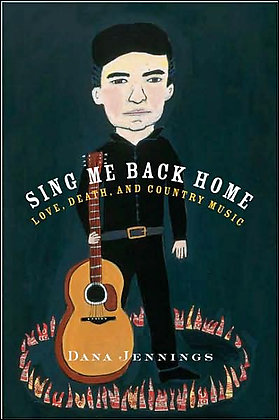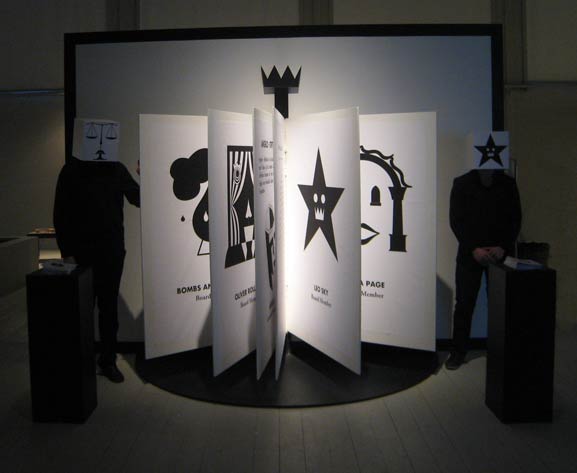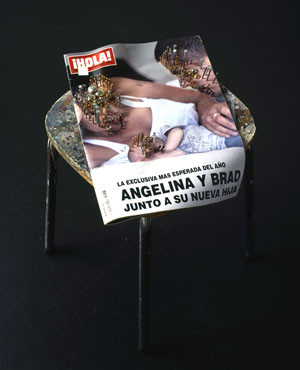Love, Death, and Country Music
By Dana Jennings
Faber and Faber.
Dana Jennings was born in the fall of 1957 to 17-year-old parents who had married only eight days earlier. "The first thing they bought of any consequence was a gray and white Sylvania record player" on which they listened to songs from "a squat glistering stack of 45 rpm records" and the two long-playing albums they owned: "Rock and Rollin' with Fats Domino" and "Johnny Cash with His Hot and Blue Guitar." These albums "became my nursery rhymes," Jennings writes. To this day "the behind-the-beat rhythm and blues of Fats Domino and his Crescent City brethren still thrill me, but it was Johnny Cash who marked me for life. My Gothic hick childhood began with that record; Cash's music steeled me for a dirt-poor world of tar-paper shacks, backwoods Grendels (my relations), and freight-train seduction."
If you're thinking this took place in Tennessee or Mississippi, think again. Jennings was born in rural New Hampshire and grew up in Kingston, a town of fewer than 1,000 residents. The local accent was Yankee cracker, but it was cracker all the same, and the music people listened to was played and sung by the likes of Johnny Cash, Patsy Cline, Jimmie Rodgers, Roy Acuff, Ferlin Husky, Loretta Lynn, Lefty Frizzell, the Carter Family, Bob Wills, Merle Haggard and the greatest of them all, Hank Williams. "The myth," Jennings says, "is that country music is purely a white, rural, and Southern art," whereas the reality is that "country musicians come from all over," from California (Merle Haggard) to Nova Scotia (Hank Snow) and just about all stops in between. Country music of what Jennings accurately calls the "golden age of twang" isn't about Dixie, though there's plenty of Dixie in it. It's about country:
Country music made between about 1950 and 1970 is a secret history of rural, working class Americans in the twentieth century -- a secret history in plain sight. . . . Country music knows that the dark heart of the American Century beat in oil-field roadhouses in Texas and in dim-lit Detroit bars where country boys in exile gathered after another shift at Ford or GM. Bobby Bare might've pleaded in 'Detroit City' that he wanted to go home. But we all knew he wouldn't, that he couldn't. Country profoundly understands what it's like to be trapped in a culture of alienation: by poverty, by a [lousy] job, by lust, by booze. . . . If you truly want to understand the whole United States of America in the twentieth century, you need to understand country music and the working people who lived their lives by it."

That's absolutely true, and Sing Me Back Home makes a powerful argument for it. Though I have serious reservations about Jennings's prose -- more on that later -- his inquiry into the great underlying themes of country music is astute and deeply informed. He takes country music seriously but never gets pompous or pretentious about it; he appreciates its humor and raunchiness as much as he values its commentary on the life of "the permanent poor white underclass -- both those who had stayed in the country and those who had strayed to the city." He doesn't draw a parallel between the history of country music and the history of jazz, but one needn't be a musicologist to understand that both genres reached their zeniths relatively early in their development -- jazz between the mid-1920s and the mid-1950s, country during the period outlined by Jennings -- and gradually lost much of their creative spark and originality as they achieved maturity. The founding fathers of the two genres, Louis Armstrong and Jimmie Rodgers, actually made a recording together in 1930 ("Blue Yodel #9"), the symbolic importance of which cannot be exaggerated: black and white together, at the dawn of American music.
The genres took different paths: Jazz went abstruse and elitist while country went slick and pop, but both lost track of their roots. With the exception of the singer Iris DeMent, Jennings doesn't find much to praise in country today: "What's marketed as country music today is actually country-style music or, to be postmodern, country music about country music." Basically this is true, though it too glibly dismisses the likes of Marty Stuart, Jerry Douglas, Ricky Scruggs and the incomparable Alison Krauss, who are trying to locate country in an altered landscape while remaining true to its soul. But its glory years fell roughly between the end of World War II and the early 1970s, between Jimmie Rodgers and Willie Nelson.
"Country music for decades was poor-people music, made by poor people and bought by poor people," Jennings writes. "It sprang from the heart and the gut, and, like R&B and soul, it was a music of exile, meant to make being banished to the margins, if not a matter of pride, then at least more tolerable." Those are the opening sentences of a chapter called "Hungry Eyes," taking the title of one of Haggard's most beloved songs as a guide to country's long connection to Americans who were going hungry, scrambling to keep their heads above water and not always succeeding. "Of all the great country singers of the 1950s and '60s," Jennings writes, "Haggard articulated rural blue-collar life best, explaining to his listeners what their lives meant and making them understand that those lives counted." Run your eyes over just about any list of Haggard's songs, and you'll see the entire country canon in miniature: "Misery & Gin," "Workin' Man Blues," "The Bottle Let Me Down," "Ramblin' Fever," "Mama Tried," "The Roots of My Raising," "Sing Me Back Home," "Always Wanting You."
It's all there: love, hunger, work, the road, booze, family, faith, infidelity, prison, loneliness, nostalgia. Chapter by chapter, Jennings explores every one of these themes, always with specific songs as points of reference. A few chapter headings from the table of contents tell the story: "Crazy," "There Stands the Glass," "Folsom Prison Blues," "King of the Road," "I'm So Lonesome I Could Cry," "Lovesick Blues." If you love country music, those are the stations of the cross, song titles that immediately conjure up not merely the songs themselves but other songs of similar import. In "There Stands the Glass," for example, Jennings cites not merely the Webb Pierce classic -- the "national anthem of barroom tunes" -- he also rounds up "What's Made Milwaukee Famous (Has Made a Loser Out of Me)," "Honky Tonk Man," "White Lightning," "Chug-A-Lug" and the Loretta Lynn classic "Don't Come Home A-Drinkin' (with Lovin' on Your Mind)," which within a single lyric manages to incorporate drink, sex, love, marriage and domestic abuse, written by a woman who "knew what it was like to be left home crying and lonely with the kids while her husband went off carousing, knew what it was like to be a glorified sperm depository."
All of these are matters with which Jennings has personal acquaintance. In his "particular chicken-scratched swatch of New Hampshire, postwar prosperity was a rumor." He "was born into a ramshackle husk of a house that had no indoor plumbing except for cold running water that froze in the pipes come winter -- and the occasional hot running rat." His family "lived in 'the other America,' busted, hurting, silent." His "was a family of mangy foxes, a sly, shifty, and shiftless lot, who, when faced with authority, licked its shiny boots. We had adulterers, drunks, and glue sniffers (ah, Testors!); wife beaters, husband beaters, and child abusers; pyros, nymphos, and card cheats; smugglers and folks who were always sticking their cold, bony hands where they didn't belong."
Incredibly, Jennings made it out of Kingston. He got himself to the University of New Hampshire, then into writing and journalism; he's published several novels and is an editor at the New York Times. The examples of his prose quoted herein make plain that he writes lucidly, but there are times -- too many of them, for my taste -- when he thumbs his nose at "the prissy conventions of grammar" and flexes his hardscrabble bona fides. One such passage, for example, is sandwiched between two perfectly conventional paragraphs. "Weren't nobody happy when Ma got pregnant with me in 1957," it begins, "what with her being barely seventeen and all and the father being my old man, who wasn't nobody's idea of a young go getter. Me? I can't complain -- I got borned, didn't I?" Et cetera. Obviously Jennings chose to go bumpkin as a way of emphasizing his deep and lasting intimacy with the music about which he writes, but for me it doesn't work. It sounds contrived and artificial. A North Carolina newspaper editor of many years past liked to call such prose "shucks and nubbins," and it seems as fake now as it did then, all the more so when the reader is fully aware that the writer is perfectly capable of using the king's English.
This is Jennings's choice and he's entitled to it, but I wish he'd resisted the temptation. Sing Me Back Home is, at its best, a very good book and a useful addition to the rather sparse literature of country music, but its lapses into mannered yokelisms diminish it considerably.
By Jonathan Yardley
Source: washingtonpost.com
Sunday, June 15, 2008; Page BW15









